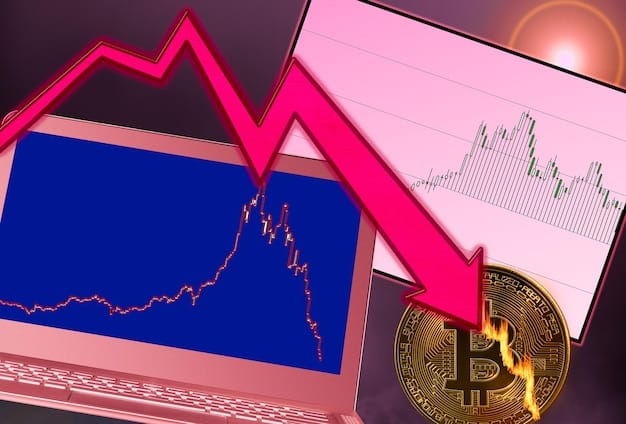Is Cryptocurrency a Hedge Against Inflation? US Investors Guide

Cryptocurrency’s effectiveness as an inflation hedge for US investors is complex, showing mixed results; while some see it as a store of value due to its limited supply, its volatility and correlation with other assets raise doubts.
Navigating the world of investments often leads US investors to explore alternative strategies for protecting their wealth against inflation, and the question, is cryptocurrency a hedge against inflation? Analyzing the data for US investors, is a hot topíc. The aim is to assess the potential of cryptocurrencies like Bitcoin as a safeguard in times of economic uncertainty.
Understanding Inflation and Its Impact
Inflation erodes the purchasing power of traditional currencies, prompting investors to seek assets that can maintain or increase their value during inflationary periods. Understanding inflation is crucial for US investors to protect their wealth.
Different types of inflation affect investment strategies in various ways. Here’s a brief overview:
- Demand-Pull Inflation: Occurs when demand for goods and services exceeds supply, leading to price increases.
- Cost-Push Inflation: Arises from increases in the costs of production, such as wages and raw materials.
- Built-In Inflation: A self-perpetuating cycle where wages and prices increase in response to each other.
Historical data reveals that assets like gold and real estate have traditionally been considered inflation hedges. However, in the digital age, cryptocurrencies have emerged as a potential alternative.
In conclusion, a solid grasp of inflation’s mechanisms and its diverse forms is foundational for any US investor aiming to safeguard their portfolio. Only with this understanding can one effectively evaluate the potential of assets like cryptocurrency as an inflation hedge.
The Allure of Cryptocurrency as a Hedge
Cryptocurrencies, particularly Bitcoin, have been touted as a digital version of gold, offering a limited supply and decentralized nature. This has led to optimism about crypto’s potential as an inflation hedge.
Bitcoin’s Scarcity and Decentralization
Bitcoin has a finite supply of 21 million coins, which contrasts with fiat currencies that can be printed by central banks. This scarcity is a key argument for its use as an inflation hedge.
Decentralized Nature
The decentralized nature of Bitcoin, outside of government or financial institution control, can make it an attractive alternative in times of economic instability.

However, the cryptocurrency market is known for its volatility, which presents a risk to investors seeking a stable hedge. Investors should carefully consider these factors before allocating capital and therefore, understand the potential of cryptocurrency as a hedge.
In conclusion, while cryptocurrency’s scarcity and decentralization may be appealing, its volatility cannot be ignored. US investors must weigh these factors carefully when considering crypto as an inflation hedge.
Analyzing the Data: Correlation or Coincidence?
Empirical data on the relationship between cryptocurrency prices and inflation rates in the US offers a mixed picture. Some studies suggest a positive correlation, while others find little to no connection.
Correlation analysis between Bitcoin and the Consumer Price Index (CPI) reveals periods of positive and negative correlation. Understanding if there is a correlation or coincidence is key to determine whether cryptocurrency is a hedge.
- Periods of Positive Correlation: During certain periods, Bitcoin’s price has increased alongside rising inflation rates.
- Periods of Negative Correlation: At other times, Bitcoin’s price has moved inversely to inflation.
- Lack of Correlation: There have also been instances where Bitcoin’s price and inflation have shown no clear relationship.
Factors such as market sentiment, regulatory developments, and macroeconomic events can influence the price of cryptocurrencies, making it difficult to isolate the impact of inflation.
Ultimately, the data suggest that the relationship between cryptocurrency and inflation is complex and not always consistent. US investors should be cautious about relying solely on crypto as an inflation hedge.

Volatility and Risk Management
The high volatility of cryptocurrencies poses a significant risk to investors, especially those seeking a stable store of value during inflationary periods. Investors must carefully consider strategies for managing that risk.
Volatility is an inherent characteristic of the cryptocurrency market. Risk management becomes essential for investors who see cryptocurrency as an strategy.
- Diversification: Spreading investments across different asset classes can help mitigate the impact of cryptocurrency volatility.
- Dollar-Cost Averaging: Investing a fixed amount of money at regular intervals can smooth out price fluctuations.
- Stop-Loss Orders: Setting predetermined exit points can limit potential losses.
Understanding one’s risk tolerance and investment horizon is crucial before investing in cryptocurrencies. Investors should assess their capacity to withstand potential losses and align their crypto investments with their long-term financial goals.
In conclusion, while cryptocurrencies may offer potential as an inflation hedge, their volatility requires careful risk management. US investors should adopt strategies to mitigate potential losses and align their crypto investments with their overall financial objectives.
Alternative Inflation Hedges for US Investors
Besides cryptocurrencies, US investors have a range of traditional and alternative assets to consider as inflation hedges. Exploring these options allows for a diversified approach to protecting wealth.
Various asset classes have historically served as inflation hedges. These alternatives allows for a diversified approach for US investors.
Gold and Precious Metals
Gold has long been considered a safe haven asset during inflationary times. Its limited supply and historical performance make it an attractive option.
Real Estate
Real estate can provide a stable source of income and capital appreciation during inflationary periods. Rental income often increases with inflation, and property values tend to rise over time.
Inflation-Protected Securities
Treasury Inflation-Protected Securities (TIPS) are designed to protect investors from inflation. Their principal value adjusts with changes in the Consumer Price Index (CPI).
Each asset class has its own set of risks and rewards. Investors should conduct thorough research and consider their individual circumstances before making investment decisions. Professional financial advice can be invaluable in navigating the complexities of inflation hedging.
In summary, US investors have several options for hedging against inflation, ranging from traditional assets like gold and real estate to inflation-protected securities. A diversified approach, tailored to individual circumstances, is often the most prudent strategy.
The Future of Cryptocurrency as an Inflation Hedge
The long-term potential of cryptocurrency as an inflation hedge remains uncertain, with both proponents and skeptics offering compelling arguments. The future is not definitive on if cryptocurrency will be a hedge.
The evolving regulatory landscape and ongoing technological developments could significantly impact the role of cryptocurrencies in the future.
- Regulatory Clarity: Clear and consistent regulations could foster greater institutional adoption of cryptocurrencies, increasing their legitimacy as an asset class.
- Technological Advancements: Improvements in scalability, security, and energy efficiency could enhance the appeal of cryptocurrencies as a store of value.
- Macroeconomic Factors: Changes in monetary policy, global economic conditions, and investor sentiment could influence the demand for cryptocurrencies as an inflation hedge.
Continued monitoring of market trends, regulatory developments, and technological innovations is essential for understanding the evolving role of cryptocurrencies in the global financial system. US investors should conduct ongoing due diligence and seek professional advice to navigate this dynamic landscape.
In conclusion, the future of cryptocurrency as an inflation hedge is subject to various factors, including regulatory developments, technological advancements, and macroeconomic conditions. US investors should remain informed and adaptable to navigate the evolving landscape of digital assets.
| Key Point | Brief Description |
|---|---|
| 💰 Inflation Impact | Inflation erodes the purchasing power of traditional currencies. |
| 🚀 Crypto as Hedge | Cryptocurrencies, like Bitcoin, are seen as digital gold. |
| 📊 Data Analysis | Data shows mixed correlation between cryptocurrency and inflation. |
| 🛡️ Risk Management | Volatility requires diversification and setting stop-loss orders. |
Frequently Asked Questions
▼
Evidence is mixed; some periods show Bitcoin rising with inflation, but its volatility and correlation with other assets complicate its role as a reliable hedge.
▼
Their decentralized nature and finite supply, like Bitcoin’s 21 million cap, mirror qualities of traditional hedges such as gold, protecting against currency devaluation.
▼
Extreme price volatility is a major risk; crypto values can swing dramatically, potentially negating its usefulness in preserving value during inflation.
▼
Yes, traditional assets like real estate, gold, and inflation-protected securities (TIPS) offer more established and potentially stable protection against inflation.
▼
Approach cautiously with diversification and risk management strategies such as dollar-cost averaging and setting stop-loss orders to mitigate potential losses during volatility.
Conclusion
In conclusion, while cryptocurrencies offer a compelling narrative as inflation hedges, the data and market realities present a mixed picture. US investors should approach crypto with caution, considering its volatility and exploring alternative, more established inflation-hedging strategies.





